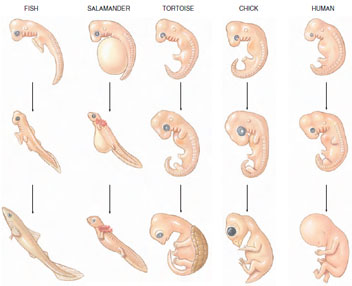The Common Vertebrate Heritage
Vertebrate
Development
The Common Vertebrate Heritage
A prominent outcome of the shared
ancestry of vertebrates is their common
pattern of development. This
common pattern is best seen in the
remarkable similarity of postgastrula
vertebrate embryos (Figure 8-19). The
likeness occurs at a brief moment in
the development of vertebrates when
the shared chordate hallmarks of dorsal
neural tube, notochord, pharyngeal
gill pouches with aortic arches,
ventral heart, and postanal tail are
present at about the same stage of
development. Their moment of
similarity—when the embryos seem
almost interchangeable—is all the
more extraordinary considering the
great variety of eggs and widely different
types of early development that
have converged toward a common
design. Then, as development continues,
the embryos diverge in pace and
direction, becoming recognizable as
members of their class, then their
order, then family, and finally their
species. The important contribution
of early vertebrate development to
our understanding of homology and
evolutionary common descent is described
in Organic Evolution in the section on
Ontogeny, Phylogeny, and Recapitulation.
The Common Vertebrate Heritage
 |
| Figure 8-19 Early vertebrate embryos. Embryos as diverse as fish, salamander, tortoise, bird, and human show remarkable similarity following gastrulation. At this stage (top row) they reveal features common to the entire subphylum Vertebrata. As development proceeds they diverge, each becoming increasingly recognizable as belonging to a specific class, order, family, and finally, species. |




